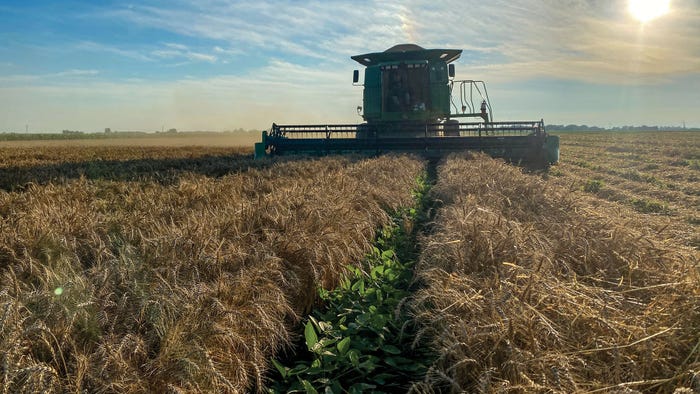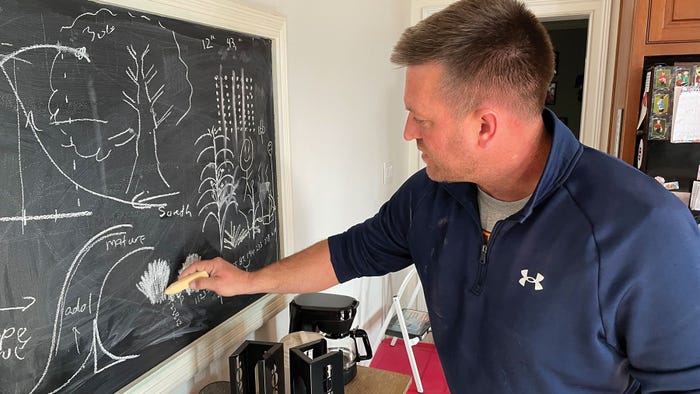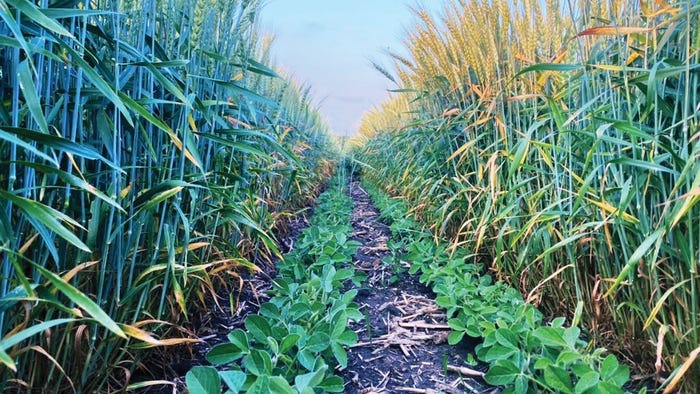You realize you’re in for something unusual the moment you arrive at Jason Mauck’s farm in Indiana. There’s a golf green and tee box behind the barn — part of a course he built so friends could play anytime. The course snakes about the farmstead like a moat around a castle. It’s just a first glimpse of Mauck’s maverick mindset.
“My story has to be told for people to understand why I’m weird and different,” he says with a hint of pride in his voice. “I’m the guy at the coffee shop who says out loud what people don’t want to say.”
The 43-year-old Mauck, who no-tills and uses cover crops on 3,000 acres near Gaston, Ind., amps up the power of sunshine to create big yield advantages by intercropping corn or soybeans with wheat.
“The result is that relay crops provide very robust soybeans,” he says. “We’ve had 108-bushel soybean relay crops. In a few spots last year, we even had 100-bushel wheat, along with 100-bushel soybeans.”
And yet, his main focus isn’t maximum yield, but maximum economic yield. Fewer inputs along with better use of space, water and sunshine jack up wheat tillering and soy nodes for top yields at a lower cost.
“This is a way to scale up regenerative farming,” Mauck says. “My aggregate costs are much lower while revenue per acre is higher. If you improve both, you improve value.”
Since he started farming, Mauck has been asking questions and vetting unconventional ideas. You could say his entire farm is one big field trial, blessed in part by manure from the 12,000-head hog operation he manages for Tyson.
The relay crops help him manage his top challenge: wet soils from a high water table. Many farmers disk, rip or pattern-tile to remove water, but Mauck doesn’t want to export water off a field if he can help it. Instead, he tries to find ways to make water seep in and not leave.
“In my situation, I’ve had too many years where too much rain has wrecked yields — times when it rains like a cow pissing on a flat rock,” he says. “But relay cropping is a way to avoid replanting from soils that get too wet. When rainfall is above normal, soybeans in relay will outperform monocrops just from the integrity of the plants.”
The ‘Edge Effect’
Mauck claims intercrop farmers can get 80% to 90% of typical yield on, in many cases, half the inputs and plant population, thanks to what he calls the “edge effect.” Monocrops compete with each other in fields, while relay crop “blocks” allow more sunlight and space for growth.
“We’ve normalized forcing plants to compete against one another,” he says. “Each plant, if you look at its circumstances, can be empowered. Healthy roots give them the ability to grow through adversity.”
Wheat blocks get sun from April through June; then, double-row soybeans claim the light and the organic matter from decaying wheat roots the rest of the growing season.

Once wheat is harvested, soybeans can feed on decaying wheat roots and gobble up sunshine, allowing better growth and yield. Credit: Jason Mauck
“It’s true I can cheat the whole system because I have hog manure,” he says. “I can grow 80% of typical wheat yields on about $16 per acre of wheat seed cost. Costs of wheat production can be lowered further with banding of fertilizer, similar to strip till. So, it’s a way to make more money on rotation than even high-yield corn.”
To make his point, Mauck hops up from his kitchen table and begins illustrating agronomy concepts on a nearby chalkboard — his frantic hands moving like a coach diagraming a Hail Mary play. Using a math theory called the Fibonacci sequence, Mauck figured out how to lower plant populations — and thus costs — and still get profitable yields.
For example, if corn population at 36,000 plants per acre equals maximum yield in a conventional setup, his calculations show that an intercrop system can cut population by half and still produce about 90% of actual production history yield.

“We’ve normalized forcing plants to compete against one another,” Mauck says, explaining agronomic concepts at his kitchen chalkboard. Credit: Mike Wilson
Relay cropping offers plants a “solar corridor,” supercharging photosynthesis on fewer but more productive plants. Those two soybean rows between the July-harvested wheat will spread out and layer on more nodes, pods and beans — not just at the top, but all along the plant.
“Instead of growing up to get light, now the soybean plant can grow outward. And the whole plant is engaged with sunlight instead of being shaded out at the bottom,” he explains. “When you harvest relay beans, you’ll have pods up and down the plant. With monocrop, the pods are on top because that’s where the light is.”

Monocrops crowd and compete with each other in vast fields, while relay crop “blocks” allow more sunlight and space for plant growth. Credit: Jason Mauck
A Different Approach
Mauck is not a do-it-the-way-Dad-did farmer. He once uprooted a cornstalk, replanted it in his garden and had his young son urinate on it daily, just to see what would happen. The stalk grew 31 ears.
After college, Mauck sold insurance but hated the suit-and-tie routine. He started a lawn service to pay tuition, and parlayed that gig into a landscaping business. Then, when Mauck was 29, his father announced he had pancreatic cancer. “Everything changed,” he recalls. “He got it in the fall and was gone by April.”
His father-in-law died a few years later, leaving Mauck with few mentors. He outsourced his landscaping business and returned to the farm just in time to slog through the 2011 “monsoon” planting season. That was just one of many difficult transitions into full-time farming.
“When your dad passes and you’re implanted into the family farm, you feel you need to earn respect by outworking everyone,” he says. “That led to mental fatigue. I’d lost my two dads and an uncle. I’d seen what they did to create this wealth, but I lost that drive to sacrifice. Having kids completely changed my mindset.”
#farmweird
Mauck’s atypical approach to farming sparks debate; he likes to get people thinking. It’s why he and others promote “#farmweird” on social media. He shares his ideas as a speaker and social media influencer with nearly 30,000 followers on platform X at @jasonmauck1.
“It’s permission for farmers to try new things in their own context,” he says. “That’s why I do what I do — to give people permission to be weird, to think how it would work on their farm, despite what their dad or grandpa did.”
Mauck says it’s OK to think outside the box, especially if it works. After all, who talks about empowering their plants?
“It may be perceived as weird, but it’s allowing people to do commonsense things and solve their own problems in their own way, and get the most out of each seed and each drop of water,” he concludes.






